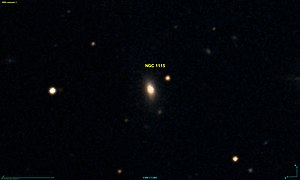NGC 1115
| Galaxy NGC 1115 |
|
|---|---|

|
|
| AladinLite | |
| Constellation | Aries |
|
Position equinox : J2000.0 , epoch : J2000.0 |
|
| Right ascension | 02 h 50 m 25.4 s |
| declination | + 13 ° 15 ′ 58 ″ |
| Appearance | |
| Morphological type | SB0 / a? |
| Brightness (visual) | 14.7 mag |
| Brightness (B-band) | 15.6 mag |
| Angular expansion | 0.6 ′ × 0.2 ′ |
| Position angle | 12 ° |
| Surface brightness | 12.4 mag / arcmin² |
| Physical data | |
| Redshift | 0.028616 ± 0.000167 |
| Radial velocity | 8579 ± 50 km / s |
|
Stroke distance v rad / H 0 |
(385 ± 27) x 10 6 ly (118.1 ± 8.3) Mpc |
| diameter | 70,000 ly |
| history | |
| discovery | Albert Marth |
| Discovery date | December 2, 1863 |
| Catalog names | |
| NGC 1115 • PGC 10774 • CGCG 440-020 • MCG + 02-08-016 • 2MASX J02502539 + 1315584 • LDCE 199 NED004 | |
NGC 1115 is a lenticular galaxy of the Hubble type S0 / a? in the constellation Aries north of the ecliptic . It is estimated to be 385 million light years away from the Milky Way and has a diameter of about 80,000 ly.
In the same area of the sky there are u. a. the galaxies NGC 1112 , NGC 1116 , NGC 1117 , IC 1852 .
The object was discovered by Albert Marth on December 2, 1863 .
